
Watch short for this article (5 slides)
Yosemite: Granite Cathedrals, Ancient Giants, and the Cradle of Conservation
Nestled within California's majestic Sierra Nevada mountains, Yosemite National Park stands as a global icon of natural grandeur. It's a landscape sculpted by immense geological forces, showcasing towering granite cliffs like El Capitan and Half Dome, cascading waterfalls including one of North America's tallest, groves of ancient giant sequoia trees, and remarkably diverse ecosystems stretching from oak woodlands to alpine meadows. Established as a national park in 1890, but with its core valley protected even earlier, Yosemite attracts millions annually, drawn by its breathtaking beauty and the profound sense of wilderness it offers. More than just a stunning landscape, Yosemite holds a pivotal place in the history of the conservation movement, inspiring generations to protect wild places.
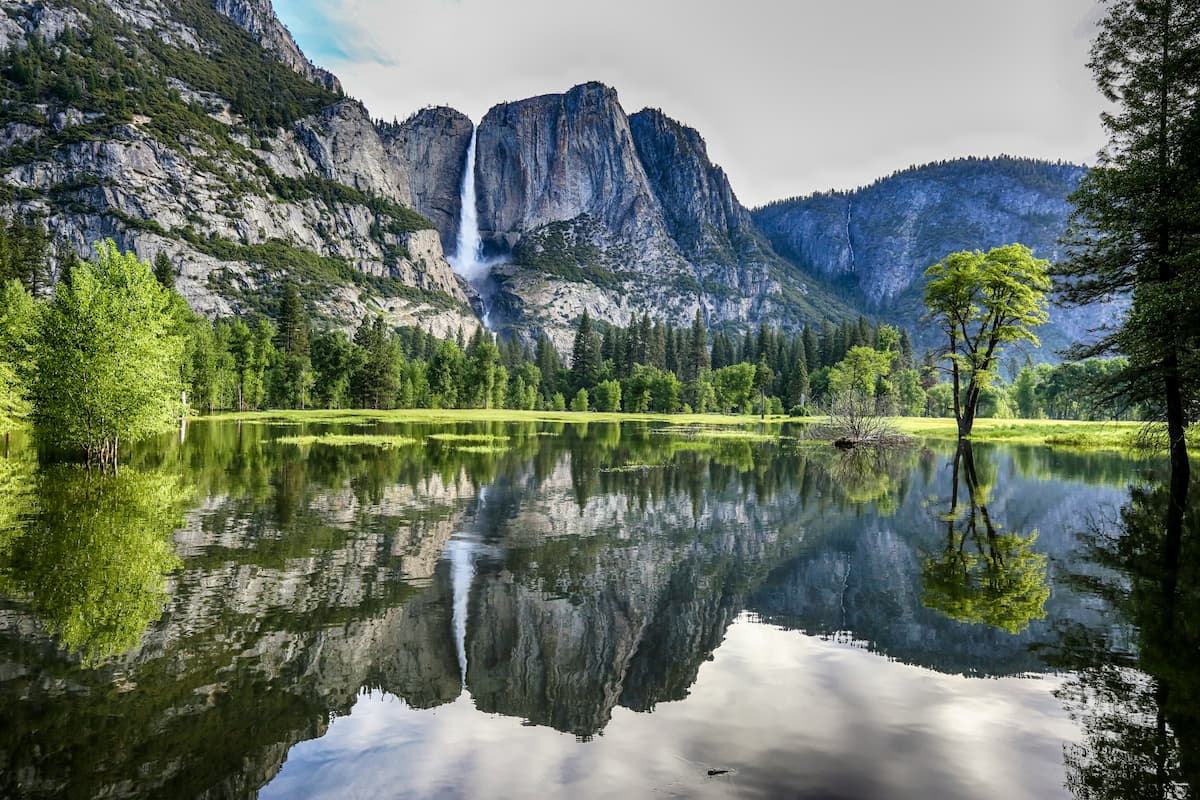
Photo by Mick Haupt on Unsplash - Yosemite Valley's dramatic cliffs and waterfalls are world-renowned.
Sculpted by Fire and Ice: Yosemite's Geological Story
The dramatic scenery of Yosemite is the result of millions of years of geological processes, primarily involving the formation of granite and the erosive power of glaciers.
- Formation of the Granite: Roughly 100 million years ago, during the Cretaceous period, molten rock (magma) cooled slowly deep beneath the Earth's surface, forming massive bodies of granite known as plutons. These plutons collectively make up the Sierra Nevada batholith. Different compositions and cooling rates resulted in distinct granite types seen today (e.g., El Capitan Granite, Half Dome Granodiorite).
- Uplift and Erosion: Over subsequent millennia, tectonic forces uplifted the Sierra Nevada block. As the land rose, rivers like the ancestral Merced River began carving canyons into the overlying rock, exposing the durable granite beneath.
- The Power of Glaciation: Starting around 2-3 million years ago and occurring in multiple waves during the ice ages (the last major glaciation ending ~10,000-15,000 years ago), massive glaciers flowed down these river canyons. These rivers of ice, sometimes thousands of feet thick, drastically reshaped the landscape. They quarried rock, widened V-shaped river valleys into the characteristic U-shape of Yosemite Valley, carved sheer cliffs, polished granite domes (like Sentinel Dome), and created hanging valleys (where tributary glaciers didn't cut as deeply as the main glacier, leaving their valleys perched high above the main valley floor, often resulting in waterfalls today).
- Post-Glacial Shaping: After the glaciers retreated, meltwater formed ancient Lake Yosemite on the valley floor. Sediment eventually filled this lake, creating the flat valley floor we see today. Rockfalls (still an active process), exfoliation (peeling of rock layers, shaping domes like Half Dome), and continued river erosion continue to subtly shape the landscape. (Source: NPS - Yosemite Geology)
Ancient Roots and a New Era: Human History
Yosemite Valley has been inhabited for thousands of years. The Southern Sierra Miwok people, particularly the Ahwahneechee band, lived in the valley, utilizing its abundant resources and holding deep spiritual connections to the land they called "Ahwahnee" (often interpreted as "place of a gaping mouth"). Their villages and pathways were woven into the landscape.
European-American discovery occurred relatively late. The Mariposa Battalion, a state militia pursuing Native Americans during conflicts related to the Gold Rush, entered Yosemite Valley in 1851. Their reports, initially met with some skepticism, soon attracted artists, photographers, and writers who documented the valley's splendor, bringing it to national attention.
This growing recognition led to a landmark conservation act. Concerned about potential commercial exploitation, influential figures advocated for protection. In 1864, during the Civil War, President Abraham Lincoln signed the Yosemite Grant Act, granting Yosemite Valley and the Mariposa Grove of Giant Sequoias to the State of California "for public use, resort, and recreation... inalienable for all time." This was a pioneering act, marking the first time land was specifically set aside by the federal government for preservation and public enjoyment, laying crucial groundwork for the national park concept. Naturalist and writer John Muir arrived in Yosemite a few years later, becoming its most passionate advocate. His writings and activism were instrumental in persuading Congress to establish Yosemite National Park in 1890, encompassing the high country surrounding the state-managed valley and grove. The state grant lands were later returned to federal control and incorporated into the national park in 1906.
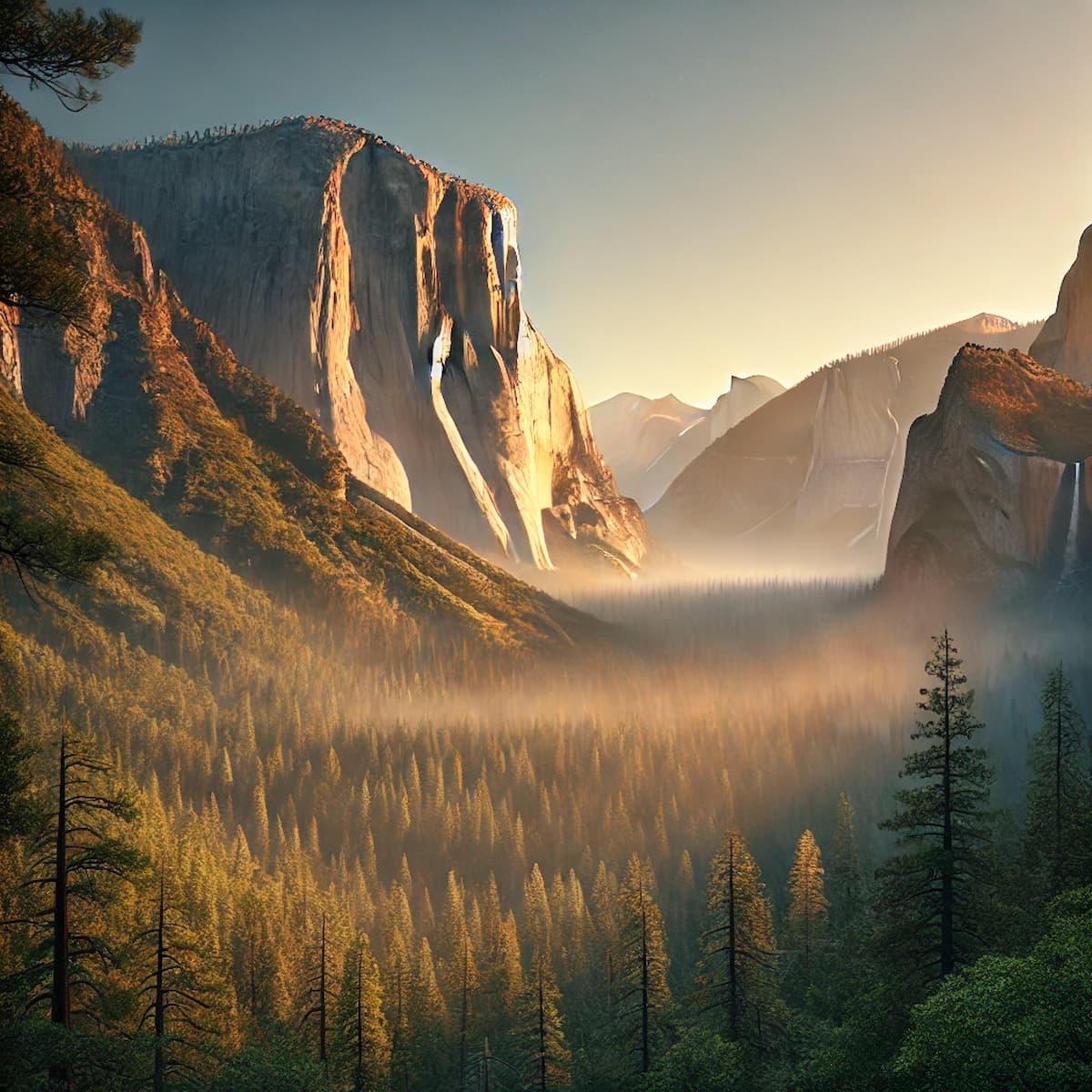
John Muir's advocacy was crucial in establishing Yosemite National Park.
Icons of Granite: El Capitan and Half Dome
Yosemite Valley is defined by its immense granite formations, two of which are globally recognized:
- El Capitan: This colossal granite monolith looms over the valley's western end, presenting a sheer cliff face with approximately 3,000 feet (914 meters) of vertical relief. Composed primarily of durable El Capitan Granite, it is revered in the rock-climbing world as a proving ground for big-wall climbing. Iconic routes like "The Nose" attract elite climbers. Its sheer scale and imposing presence make it a dominant feature visible from many valley viewpoints, particularly El Capitan Meadow.
- Half Dome: Perhaps Yosemite's most distinctive landmark, Half Dome rises dramatically to an elevation of 8,836 feet (2,693 meters) at the eastern end of the valley. Its unique shape results from glacial quarrying carving away one side, while the rounded back was shaped by exfoliation (the peeling away of curved shells of rock). Hiking to the summit is a strenuous 14-16 mile round trip involving a challenging final ascent up the dome's shoulder using fixed steel cables (permits required via lottery due to high demand). Its image is synonymous with Yosemite. (Source: NPS - Half Dome Permits)
Thundering Waters: Yosemite's Famous Falls
Fed by snowmelt from the high country, Yosemite's waterfalls are most spectacular in late spring and early summer (typically May and June). Many diminish significantly or dry up completely by late summer or fall.
- Yosemite Falls: One of the tallest waterfalls in North America and fifth tallest in the world, Yosemite Falls plunges a total of 2,425 feet (739 meters) in three sections: Upper Yosemite Fall (1,430 ft), the Middle Cascades (675 ft), and Lower Yosemite Fall (320 ft). An accessible trail leads to the base of Lower Fall, while strenuous trails climb to the top of the falls offering incredible views.
- Bridalveil Fall: Greeting visitors near the valley entrance, Bridalveil Fall drops 620 feet (189 meters). Its name comes from the way light breezes often blow the light spray sideways, resembling a bride's veil. Unlike many other falls, it typically flows year-round, though its volume fluctuates dramatically.
- Other Notable Falls: The Mist Trail provides thrilling, close-up views of Vernal Fall (317 ft) and Nevada Fall (594 ft) along the Merced River. Sentinel Fall, Ribbon Fall (North America's tallest single-drop waterfall when flowing), and Horsetail Fall (famous for the February "Firefall" phenomenon when sunset illuminates it) add to the park's hydrological spectacle.
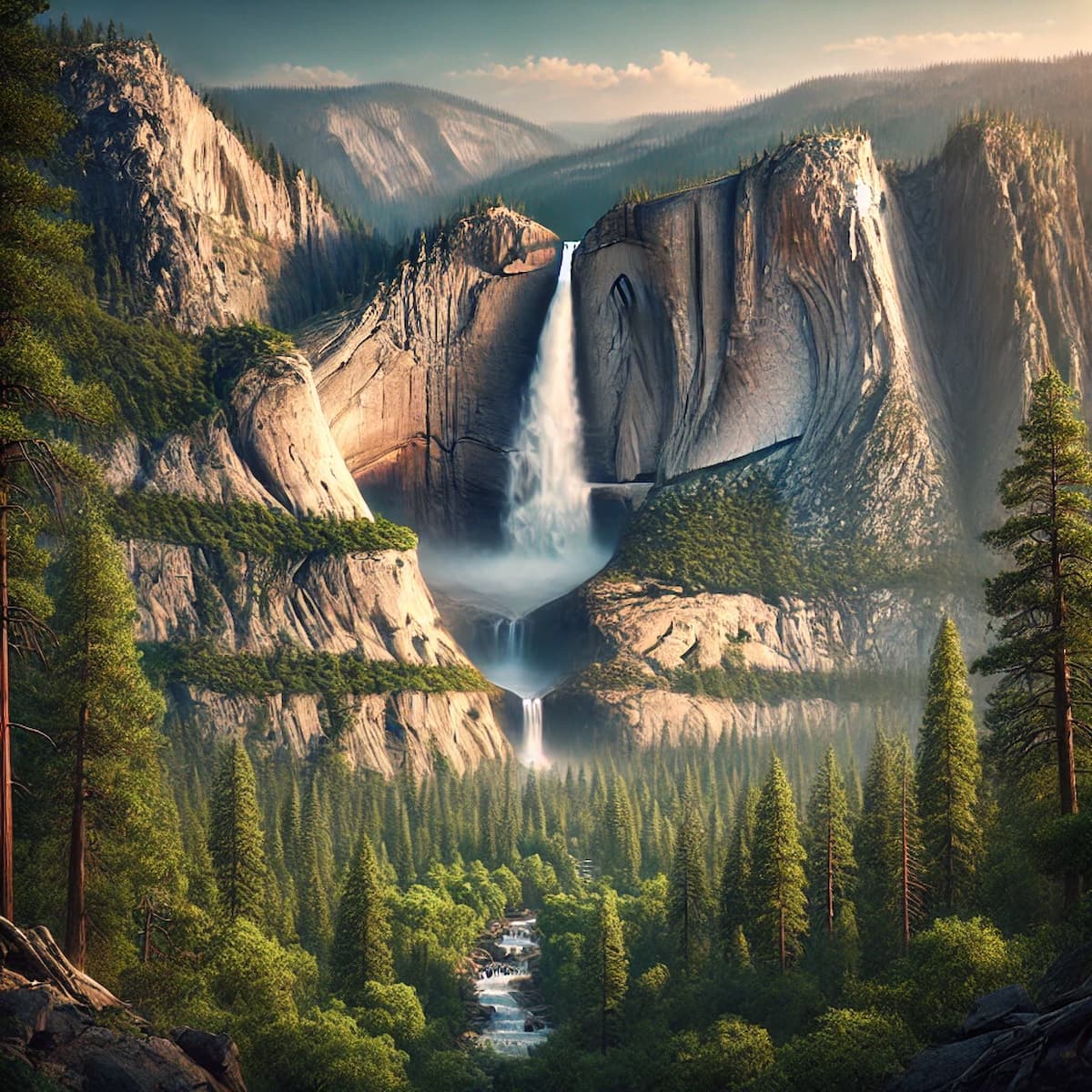
Bridalveil Fall is known for the misty, veil-like appearance created by the wind.
Ancient Sentinels: The Giant Sequoias
Yosemite protects three groves of magnificent giant sequoias (Sequoiadendron giganteum), the world's most massive trees.
- Mariposa Grove: The largest and most famous grove, located near the south entrance, was central to the original Yosemite Grant. It contains several hundred mature sequoias.
- Notable Trees: The Grizzly Giant is one of the most renowned trees in the grove, estimated to be around 3,000 years old, standing over 200 feet tall with a base circumference of nearly 100 feet. Other famous trees include the Bachelor and Three Graces and the Faithful Couple. (Note: The original "California Tunnel Tree" in Mariposa Grove fell in 1969; the Wawona Tunnel Tree in this grove was also a tourist attraction before its demise).
- Ecology: Giant sequoias thrive in specific conditions of elevation, moisture, and sunlight found only on the western slopes of the Sierra Nevada. They possess remarkable adaptations, including thick, fire-resistant bark and cones that often require fire to open and release seeds, highlighting the crucial role of natural fire regimes in their ecosystem. (Source: NPS - Giant Sequoias)
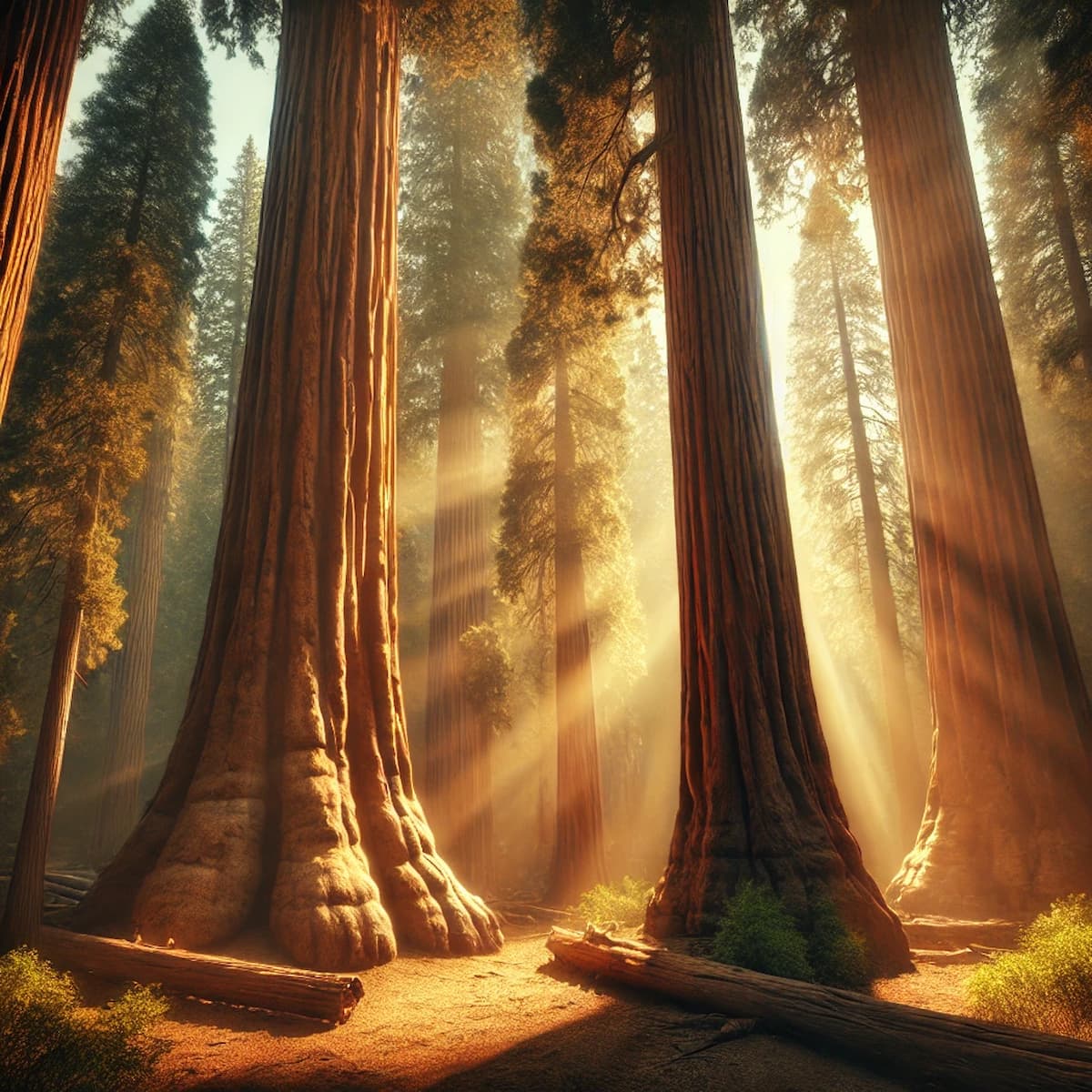
Mariposa Grove protects some of the largest and oldest living organisms on Earth.
Ecological Tapestry: From Valley Floor to Alpine Peaks
Yosemite's dramatic elevation range – from around 2,000 feet (600 m) to over 13,000 feet (4,000 m) – creates a remarkable diversity of habitats:
- Foothills (Lower Elevations): Characterized by oak woodlands, chaparral, and foothill pines. Hot, dry summers prevail.
- Montane Forests (Mid-Elevations): Home to extensive forests of ponderosa pine, incense cedar, white fir, sugar pine, and giant sequoias. Yosemite Valley sits within this zone.
- Subalpine Zone: Dominated by lodgepole pine, red fir, and Jeffrey pine, with open meadows. Winters are long and snowy. Tuolumne Meadows, a vast subalpine meadow complex accessible via Tioga Road (summer only), is a prime example.
- Alpine Zone (Above Treeline): Harsh conditions of cold, wind, and a short growing season support only low-growing cushion plants, grasses, and wildflowers amidst rocky terrain.
- Wildlife: This habitat diversity supports iconic species like black bears (often seen in valleys and meadows), mule deer, coyotes, bobcats, marmots, pikas (high elevations), Sierra Nevada bighorn sheep (recovering populations), peregrine falcons, and over 250 bird species. Maintaining ecological integrity requires managing human impacts and natural processes like fire.
A Playground for Adventure: Outdoor Recreation
Yosemite offers unparalleled opportunities for outdoor recreation:
- Hiking and Backpacking: Over 800 miles of trails cater to all levels. Popular day hikes include the Mist Trail, Yosemite Falls Trail, Mirror Lake loop, and trails in Tuolumne Meadows and Mariposa Grove. Multi-day backpacking trips into the vast wilderness require permits and careful planning.
- Rock Climbing: Yosemite Valley is a world-renowned climbing destination, attracting climbers globally to challenge its granite walls, from single-pitch routes to multi-day big-wall ascents on El Capitan and Half Dome. Bouldering is also popular.
- Sightseeing and Photography: Iconic viewpoints like Tunnel View, Glacier Point (accessible by car in summer), Olmsted Point (along Tioga Road), and Valley View offer stunning photographic opportunities.
- Camping: Numerous campgrounds in the valley and high country offer sites for tents and RVs (reservations are highly competitive and often essential).
- Winter Sports: When snow arrives, opportunities include cross-country skiing, snowshoeing (especially around Badger Pass ski area and Crane Flat), and ice skating at the Curry Village rink.
Stewardship and Future Challenges
Managing Yosemite involves balancing immense popularity with the mandate for preservation. The NPS, often in partnership with organizations like the Yosemite Conservancy, addresses critical issues:
- High Visitation: Managing traffic congestion, crowding at popular sites, impacts on trails and resources, and visitor safety, leading to reservation systems during peak seasons.
- Fire Management: Restoring natural fire cycles through prescribed burns and managing increasingly large and intense wildfires fueled by past suppression practices and climate change.
- Ecological Restoration: Projects like the Merced River Plan aim to restore natural river dynamics and meadow habitats impacted by past development.
- Climate Change Impacts: Addressing threats like reduced snowpack affecting waterfalls and water supply, increased tree mortality due to drought and pests, shifts in wildlife ranges, and more frequent extreme weather events.
- Infrastructure Maintenance: Maintaining roads, trails, buildings, and utility systems within the park.
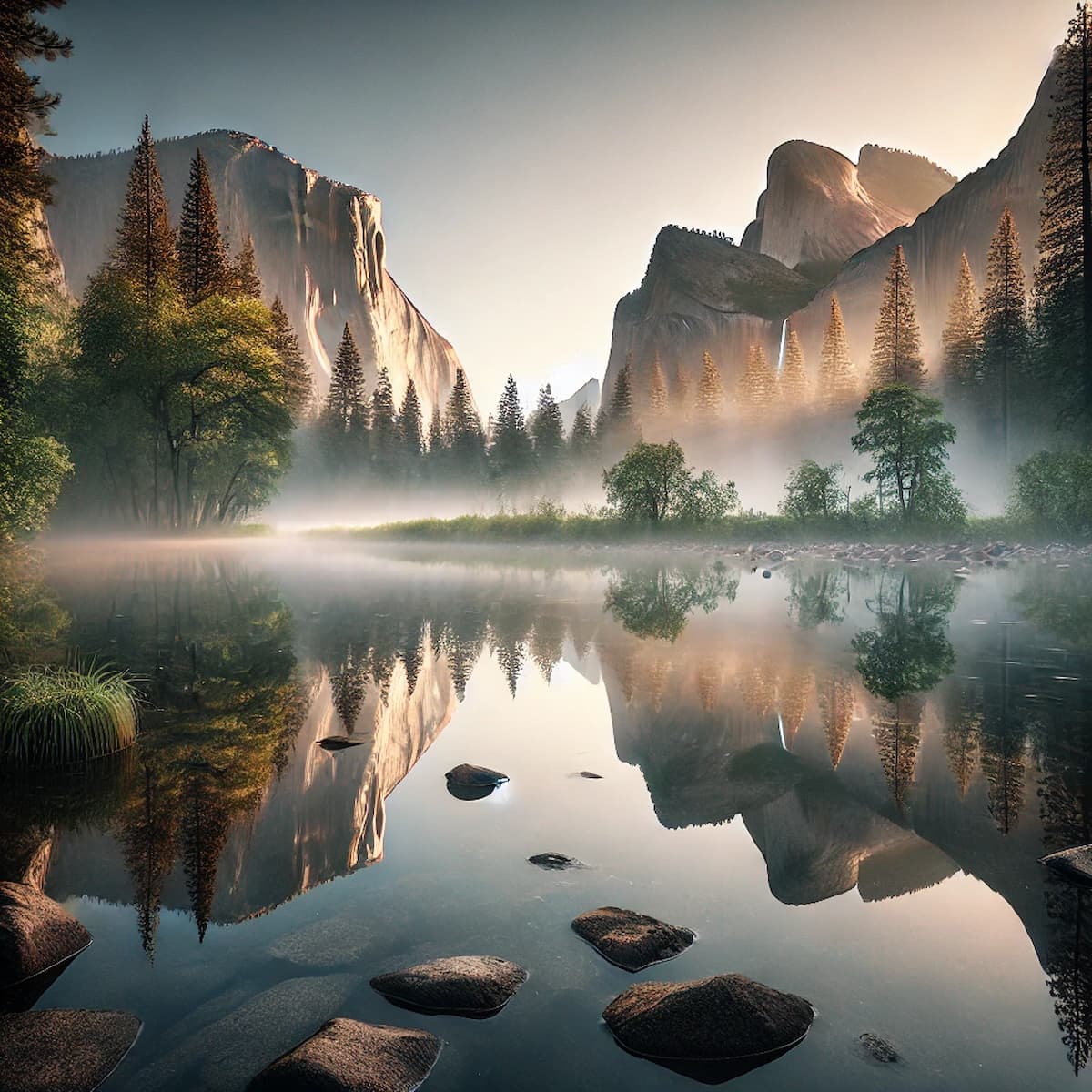
Conclusion: An Enduring Legacy
Yosemite National Park is far more than just a collection of beautiful sights; it is a dynamic landscape forged by geological time, a sanctuary for biodiversity, a touchstone in the history of American conservation, and a place that evokes deep emotional and spiritual responses. From the sheer granite face of El Capitan to the ancient wisdom embodied by the giant sequoias and the life-giving rush of its waterfalls, Yosemite offers profound experiences. Its legacy challenges us to appreciate not only its immense beauty but also the critical importance of preserving such irreplaceable natural and cultural treasures for the inspiration and benefit of generations to come.